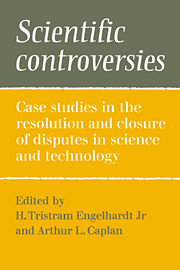 Scientific Controversies
Scientific Controversies Book contents
- Frontmatter
- Contents
- Preface
- List of contributors
- Introduction: Patterns of controversy and closure: the interplay of knowledge, values, and political forces
- PART I THEORETICAL PERSPECTIVES
- 1 Ethical theory and the problem of closure
- 2 Scientific controversy and its termination
- 3 The political anatomy of controversy in the sciences
- 4 Controversies involving science and technology: a theoretical perspective
- 5 Politics, public policy-making, and the process of reaching closure
- 6 The role of experts in scientific controversy
- 7 The continental drift debate
- 8 How history and politics affect closure in biomedical discussions: the example of the Soviet Union
- 9 Scientific disputes over policy
- 10 Controversies and the authority of science
- 11 Post-Skinner and post-Freud: philosophical causes of scientific disagreements
- PART II CONTEMPORARY CASE STUDIES
- PART III CONTROVERSY, CLOSURE, AND THE PUBLIC
- Author index
- Subject index
7 - The continental drift debate
Published online by Cambridge University Press: 03 February 2010
- Frontmatter
- Contents
- Preface
- List of contributors
- Introduction: Patterns of controversy and closure: the interplay of knowledge, values, and political forces
- PART I THEORETICAL PERSPECTIVES
- 1 Ethical theory and the problem of closure
- 2 Scientific controversy and its termination
- 3 The political anatomy of controversy in the sciences
- 4 Controversies involving science and technology: a theoretical perspective
- 5 Politics, public policy-making, and the process of reaching closure
- 6 The role of experts in scientific controversy
- 7 The continental drift debate
- 8 How history and politics affect closure in biomedical discussions: the example of the Soviet Union
- 9 Scientific disputes over policy
- 10 Controversies and the authority of science
- 11 Post-Skinner and post-Freud: philosophical causes of scientific disagreements
- PART II CONTEMPORARY CASE STUDIES
- PART III CONTROVERSY, CLOSURE, AND THE PUBLIC
- Author index
- Subject index
Summary
The sixty-year-old controversy among earth scientists about the reality of continental drift that ended about fifteen years ago stands in stark contrast to the other controversies addressed by participants in the Closure Project. Unlike most of the other controversies, that of continental drift was not a public policy controversy with technical or scientific components. Nor was it a scientific controversy having significant political, economic, or social aspects. It was a controversy among earth scientists about problems within the earth sciences.
Despite the fact that the drift controversy did not involve issues of public policy, it has an interesting dynamics of its own. The major aim of this chapter is to offer an analysis of its dynamics. In the second section of the chapter, I will give a capsule history of the controversy – long enough to provide a defense of my analysis but short enough not to overburden the reader with too much detail. The analysis of the overall controversy is offered in the third section of the chapter. In short, I argue the following:
Proponents of competing theories attempt to provide solutions to a common nest of problems that constitute the subject matter of the controversy.
Proponents of competing theories attempt to bring up difficulties with their opponents' solutions.
Such attacked solutions are defended against the difficulties raised by altering the solutions so as to avoid the difficulties or showing that the difficulties are ill founded. Sometimes the attacked solution is simply replaced by a new solution that avoids the difficulties.
[…]
- Type
- Chapter
- Information
- Scientific ControversiesCase Studies in the Resolution and Closure of Disputes in Science and Technology, pp. 203 - 248Publisher: Cambridge University PressPrint publication year: 1987
- 15
- Cited by


